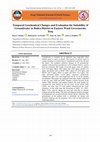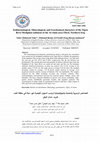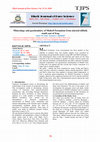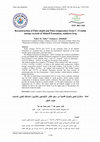Papers by Taher M A H M O O D Taha

Groundwater is essential for its different uses, especially when surface water is scarce or absen... more Groundwater is essential for its different uses, especially when surface water is scarce or absent. The scarcity of surface water in various locations in eastern Iraq is a significant concern for life and the future. The temporal chemical changes of 20 groundwater samples collected from groundwater wells in Badra District, eastern Iraq are evaluated. The results reveal the mean values of cations; Ca2+ (215 ppm), Mg2+ (100.7 ppm), Na+ (256.5 ppm), and K+ (3.5 ppm), and anions such as SO42-(956.7 ppm), Cl-(342 ppm), and HCO3-(48.13 ppm), PO43-(3 ppm) and NO3-(21.5 ppm). The total dissolved solids (2128 ppm), electrical conductivity (3084µs\cm), pH (7.43), and temperature (20.18 °C) of the samples are obtained. The results are compared with other studies conducted in the two years (2005 and 2009). Despite a relative increase in the sulfate, TDS, chlorides, and sodium contents, the water quality has remained the same during the last ten years. In the recent study (2020), the same type of water quality characterized the water chemistry. At the same time, the increasing of SO42-, Cl-, NO3-, Mg2+, Ca2+, and K+ during ten years ago were due to climatic changes toward the aridity. The observed temporal chemical changes of groundwater are consoled with the climatic factors' alteration. The groundwater of the studied wells is unsuitable for human and livestock drinking and for irrigation with a risk of total dissolved solids and sulfates.

Thirteen samples of sediment were collected from the
Tigris River between Hammam Al-Aleel and Fat... more Thirteen samples of sediment were collected from the
Tigris River between Hammam Al-Aleel and Fat'ha
area, northern Iraq to determine the texture of these
sediments, clay mineral assemblages and
concentrations of some heavy metals. The grain size
analysis of the samples revealed that the silt fraction
is the most dominant type in the studied samples, and
the size decreases down-stream in accordance with
the river's morphology and gradient. The clay
fraction was examined by employing XRD to
recognize the clay mineral types. It was found that
montimorillonite is the most dominant mineral, in
addition to illite, palygoriskite, kaolinite and chlorite.
The heavy metal elements were determined by
Atomic Adsorption Spectrum (AAS) instrument and
they included Zinc (Zn), Copper (Cu), Cobalt (Co),
Cadmium (Cd) and Lead (Pb) in the clay fraction.
However, due to human activities like fertilization of
soil and industrial water, such elements as Pb (163
ppm), Zn (121 ppm), Co (33 ppm) were higher than
the normal concentration, while the concentration of
Cu (42 ppm) was lower than the normal.

Iraqi Journal of Science, 2023
The mineralogical investigation, geochemical analysis, and grain size calculation were carried ou... more The mineralogical investigation, geochemical analysis, and grain size calculation were carried out for floodplain sediment in the Tigris River to identify the properties of the sediment. The average values of the three main sediment classes, very fine sand, silt, and clay are 9.67, 62.53 and 27.80%, respectively. The silt size fraction was predominant. The classification and nomenclature of surface sediment types from the floodplain of the Tigris River are sandy-silt and mud, and they are the dominant sediment. Statistical parameters of grain size analysis refer to the average of the median values 3.74 Φ very fine sand; mean in average 6.16 Φ coarse silt; standard deviation evident by average 1.30 Φ poorly sorted, skewed; in average-0.14 negatively skewed, and the average of Kurtosis 2.80 very leptokurtic. The samples analysed by the XRD technique revealed clay minerals (chlorite, illite, montmorillonite, and kaolinite) and non-clay minerals (quartz, feldspar, calcite, and dolomite). The heavy minerals identified as species were zircon, tourmaline, rutile, garnet, olivine, hornblende, pyroxene, kyanite, and magnetic particles. The concentration of major oxides by geochemical analysis indicates a high content of SiO2 and CaO in the floodplain of the Tigris river.

Tikrit Journal of Pure Science, 2020
Mi shrif Formation (Late Cenomanian) has been studied in four oilfields in southern Iraq, and stu... more Mi shrif Formation (Late Cenomanian) has been studied in four oilfields in southern Iraq, and studied samples were examined by mineralogy and geochemistry analysis using XRF and XRD techniques. The mineralogical study reveals that dolomite and calcite are the main minerals in the rock formation in studied oil fields, whereas quartz and clay minerals (kaolinite, montmorillonite and illite) represent secondary minerals composition. For geochemical classification of Mishrif rock, Ca/Mg ratio was applied and this reveals that Calcitic Limestone is a major type in studied samples. The paleo-salinity has been examined by using Ca/Mg and Mg/Ca ratios and they referred to moderate salinity during deposition. Mg/Ca and Mn/Ca ratios have been applied to measure paleo-temperature, so infer a moderate paleo-temperature for Mishrif Formation in studied samples. Based on the comparison between low Sr/Ca and the relatively high Ca/Mg ratios, infer that a dolomitization process played the main role among diagenesis processes.

Iraqi Journal of Science, 2019
Stable isotopes 18 O/ 16 O and 13 C/ 12 C in the carbonate rocks of the Mishrif Formation are exa... more Stable isotopes 18 O/ 16 O and 13 C/ 12 C in the carbonate rocks of the Mishrif Formation are examined here to define the depositional characters in the basin includes paleo temperatures and paleo depth. The Mishrif formation (Cenomanian-Early Turonian) has extensive distribution in Iraq and Middle East. Mishrif Formation composed of organic detrital limestone. Four boreholes in four oilfields, Noorwell (11), Amarahwell (14), Buzurganwell (24), Halfayawell (8), in south east of Iraq have been studied. The studied samples have negative δ 18 O isotope values studied well, with Average (-4.11‰), (-4.47‰), (-4.48‰), (-4.18‰) in the studied wells respectively. Carbon Isotope composition positive values in the study samples, with average (2.32‰), (1.84‰), (2.20‰), (2.24‰) are studied well respectively. The Stable isotope (18 O/ 16 O and 13 C/ 12 C) of Mishrif Formation provide the first records of paleotemperature for the (Cenomanian-Early turanian) which indicate moderate during deposition. The plot of depositional environment refers to warm water carbonate sediment and the bulk samples cluster tightly to small positive reflect modal isotope composition of dominant skeletal marine carbonate. The paleo-salinity (Z values) provide the marine deposits in studied samples. As the paleo-temperature was high temperature by (T values). The paleo depth he all studied samples in the four oilfields are fall in the same level which is in the upper part of Thermocline this indicate the moderate depth

Uploads
Papers by Taher M A H M O O D Taha
Tigris River between Hammam Al-Aleel and Fat'ha
area, northern Iraq to determine the texture of these
sediments, clay mineral assemblages and
concentrations of some heavy metals. The grain size
analysis of the samples revealed that the silt fraction
is the most dominant type in the studied samples, and
the size decreases down-stream in accordance with
the river's morphology and gradient. The clay
fraction was examined by employing XRD to
recognize the clay mineral types. It was found that
montimorillonite is the most dominant mineral, in
addition to illite, palygoriskite, kaolinite and chlorite.
The heavy metal elements were determined by
Atomic Adsorption Spectrum (AAS) instrument and
they included Zinc (Zn), Copper (Cu), Cobalt (Co),
Cadmium (Cd) and Lead (Pb) in the clay fraction.
However, due to human activities like fertilization of
soil and industrial water, such elements as Pb (163
ppm), Zn (121 ppm), Co (33 ppm) were higher than
the normal concentration, while the concentration of
Cu (42 ppm) was lower than the normal.
Tigris River between Hammam Al-Aleel and Fat'ha
area, northern Iraq to determine the texture of these
sediments, clay mineral assemblages and
concentrations of some heavy metals. The grain size
analysis of the samples revealed that the silt fraction
is the most dominant type in the studied samples, and
the size decreases down-stream in accordance with
the river's morphology and gradient. The clay
fraction was examined by employing XRD to
recognize the clay mineral types. It was found that
montimorillonite is the most dominant mineral, in
addition to illite, palygoriskite, kaolinite and chlorite.
The heavy metal elements were determined by
Atomic Adsorption Spectrum (AAS) instrument and
they included Zinc (Zn), Copper (Cu), Cobalt (Co),
Cadmium (Cd) and Lead (Pb) in the clay fraction.
However, due to human activities like fertilization of
soil and industrial water, such elements as Pb (163
ppm), Zn (121 ppm), Co (33 ppm) were higher than
the normal concentration, while the concentration of
Cu (42 ppm) was lower than the normal.